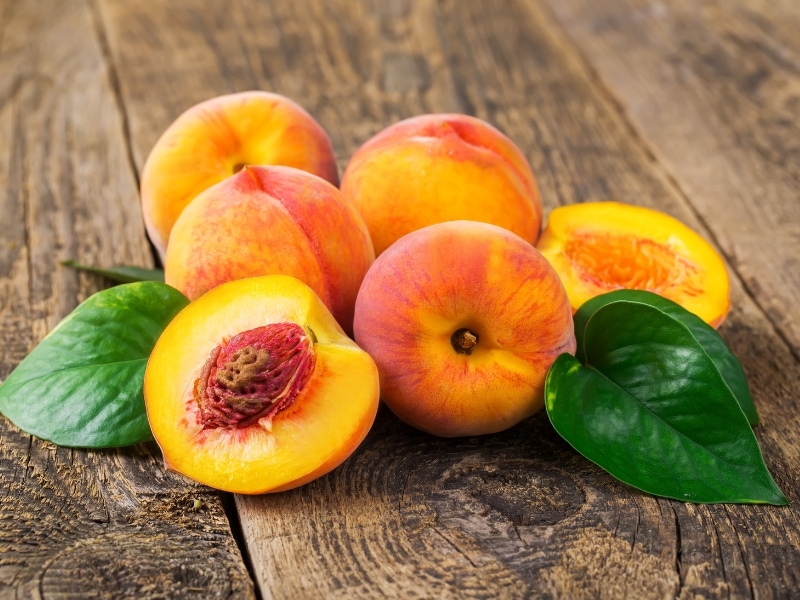Peaches, mangoes, and plums, oh my! They’re all in the same family, but really, what is stone fruit?
Stone fruits, also known as drupes, are indehiscent fruits with a stone or pit surrounded by sweet flesh, like peaches or plums. However, individual drupes, like raspberries, are also in the same family. Such aggregate, or compound, drupes are made up of smaller drupelets that contain seeds.

Drupes? Raspberries? What?
Don’t worry, I’ll go into the specifics below.
But for now, just keep in mind that there are so many different kinds of stone fruits.
Some are familiar and easy to define, while others may surprise you. One thing they all have in common? They’re irresistible!
What Is a Stone Fruit?
Stone fruits get their name from the stone or pit found in the middle. They’re indehiscent fruits, which means they don’t split open to release their seeds when ripe. Stone fruits typically have thin, edible skins, and they ripen quickly after harvesting, making them very seasonal.
Basically, any fruit with soft flesh surrounding a singular pit is a stone fruit.
So, cherries, peaches, and olives are all types of stone fruits with pits and edible skins.
But there are other types that don’t follow that description.
Mangoes, for example, have a large stone in the middle of all that sweet flesh, but we don’t usually eat the skin.
And then there’s the wild cards! I’m talking about certain berries and coconuts.
Yes, coconuts!
Read on to learn more.
Different Types of Stone Fruits

1. Peaches
Let’s start with one of the most common and recognized stone fruits around – the ever-popular peach!
Known for their fuzzy skin and soft, sweet flesh, you’ll never go wrong with peaches.
Available in a few varieties, including yellow and white, they’re harvested between June and August, making them a favorite for summer desserts.
Recipe: Easy Peach Crisp Recipe

2. Plums
Plums are an extremely juicy fruit with a delectably sweet flavor.
Depending on the type, plums can be yellow, red, or even black on the inside. And the thin outer skin usually ranges from bright red to black.
Plums taste great in baked goods, and they’re perfect for salads or snacking.
They’re usually available from July until October.
Recipes: 20 Best Plum Desserts

3. Nectarines
Similar to peaches, nectarines are a delicious stone fruit with a large pit. One of the main differences, though, is that nectarines don’t have fuzzy skin.
Nectarines aren’t as soft as a peach, either. Instead, the texture is much firmer, like an apple.
Despite their differences, nectarines can be used interchangeably with peaches. And they’re harvested around the same time.
So bake with them, toss them in a salad, or stuff them in a pie. You won’t be disappointed.
Recipes: 20 Best Nectarine Dessert Recipes

4. Apricots
Another stone fruit sister to peaches and nectarines is the apricot. These small, yellow, and juicy fruits have smooth skin and bright-colored flesh.
Apricots are also tart with a creamy, velvety texture. Plus, the skin is filled with lots of pectin, making them an excellent option for jams and jellies.
If you’ve ever had dried apricot before, you’ll know it’s sweet, chewy, and perfect for baking with.
They’re available from May to September.
Recipes: 25 Fresh Apricot Desserts

5. Cherries
Cherries are a type of small stone fruit and the first to appear in the early spring. You’ll start to see them around mid-April until late July.
Available in many different types, some are incredibly sweet while others are perfectly tart.
They also range from yellowish-red to deep burgundy in color.
Sweet cherries make a great late-night or midnight snack since they’re high in melatonin.
Recipe: Cherry Cobbler with Cake Mix

6. Mangoes
Mangoes are a fun tropical stone fruit that everybody loves.
They have a large, oddly shaped pit that can be challenging to cut out of the flesh. But despite the extra work, mangoes are worth it.
They’re sweet, juicy, slightly tart, and delicious. Add them to a fruit salad, smoothies, cakes, quick breads, and more.
Or toss slices in chili lime seasoning with a drizzle of lime juice for an irresistible snack.
Depending on where you are, they’re available at different times of the year. But the peak season is from May until September.
Recipe: Mango Habanero Chicken Wings

7. Dates
Although you may not think of them this way, dates are a tropical fruit! They grow on palm trees and can be enjoyed fresh or dried.
Super chewy and sweet, dates come in a variety of colors that range from yellow to brown.
You can eat dates as a sweet snack or throw them into smoothies and baked items. They’ll naturally sweeten your dishes and add fiber to your diet.
And since they’re most often bought and consumed dried, they’re available all year.
Recipe: Date Cake With Raisins and Nuts

8. Lychees
Lychee fruits are easy to spot, thanks to their super unique appearance.
On the outside, lychees look a bit like dried strawberries with bumpy skin. The outside is bright reddish-pink, and the flesh is white or transparent.
The flavor is often described as somewhere between a grape and a pear. They are most often found in cocktails and are harvested from May until July.
Recipes: 10 Fresh Lychee Cocktails

9. Raspberries
I know what you’re thinking: where’s the “stone” in a raspberry? And isn’t it a berry?
Well, you know those tiny, bulbous bits with sweet juice inside? That’s a drupelet!
The tiny seeds are in each of them. So each raspberry is a whole cluster of stone fruits. Fascinating, right?
Raspberries are intensely sweet, really versatile, and make a great snack. They pair well with chocolate or yogurt and can be added to most baked goods.
Available fresh from June until August, you can also find them frozen year-round.
Recipes: 10 Easy Raspberry Smoothie Recipes

10. Blackberries
Similar to raspberries, blackberries are made up of tiny stone fruits (drupelets).
These babies are sweet and very dark in color. They’re also super juicy and loaded with intense berry flavor.
Unfortunately, blackberry season is very short. It typically runs from July until August. So take advantage of it when you can!
Try them in pies, parfaits, cakes, and so much more.
Recipe: Blackberry Jam Recipe

11. Mulberries
Mulberries are very similar to blackberries and raspberries. But where the above two look like siblings, this one is made up of elongated clusters of baby drupes.
And they have a wide range of colors, too. You’ll see them from red to dark purple and sometimes white.
They’re also more likely to be found in your backyard than in a grocery store between June and August.
Use mulberries in smoothies or bake them into a pie. Either way, this special stone fruit is delicious.
Recipes: 20 Best Mulberry Recipes

12. Olives
Despite their salty and savory flavor, olives are a fruit. And stone fruits, at that!
They come in lots of different colors and flavors, from black and purple to green. And they’re actually inedible before they’re cured (when they’re raw).
The curing process has a huge effect on their coloring and taste. It often involves curing/fermenting the fruits in brine or salt.
So while they’re harvested at specific times, they’re sold in jars or cans year-round.
Use olives in salads, on charcuterie boards, and on pizza!
Recipes: 25 Best Olive Recipes

13. Coconuts
Contrary to popular belief, coconuts are not a nut. They’re stone fruits.
More specifically, the coconut we eat is actually the pit!
They’re usually green straight from the tree with a fibrous outer flesh that’s tough to get through.
Once you get to the pit in the middle, you can crack it open. The inside will reveal sweet, creamy, bright white flesh.
Use coconut in baking, soups, and seafood dishes.
Recipe: 5-Ingredient Chewy Coconut Macaroons

14. Hybrid Fruits
Stone fruit hybrids are a fun addition to the stone fruit family. And there are three common types:
- Pluots are a combination of plums and apricots. They’re sweet, juicy, and more plum than apricot.
- Plumcots are half plum and half apricot. The tart and sweet flavors are balanced perfectly.
- Apriums lean more towards the apricot side. As a result, they have a little more tartness than the other varieties.
Use these the same as other stone fruits in dishes like salads or baked goods.

Stone Fruit Season
Stone fruit season spans the majority of the year.
- Cherries and apricots are available from the early spring to the middle or late summer.
- Mangoes, peaches, nectarines, and plums are grown into the early fall.
But then there’s the Southern Hemisphere to consider:
- Most stone fruits in the U.S. are harvested somewhere from late spring to early fall (April-October).
- They’re harvested between November and May in places like Australia (their spring-fall season).
How to Tell if Stone Fruit Is Ripe
Well, it depends.
Most stone fruits, like peaches, mangoes, and apricots, will continue to ripen after they’re harvested.
So you can buy them when they’re firm and find they’re soft in just a couple of days.
For softer stone fruits, like peaches and plums, they’ll feel a little softer and have a nice fragrance.
If they’re firm, they’re not ready.
As for the drupelets, they’ll be fragrant too. But really, it’s easiest just to taste one!
That said, some stone fruits, like cherries, don’t ripen any further after they’re harvested. So they’re ready to eat right away!
How to Store Stone Fruits
You’ll want to keep stone fruits at room temperature until they’re ripe. Just leave them on the counter or in a fruit bowl and check on them regularly.
Some stone fruits ripen really quickly, others may take a few extra days.
If you’re in a time crunch, place them in a paper bag and close it. This will trap the ethylene they emit and speed up the ripening process.
Once ripe, keep them in the refrigerator to stall the process. You’ll get a few more days to enjoy your fruit at its best.











